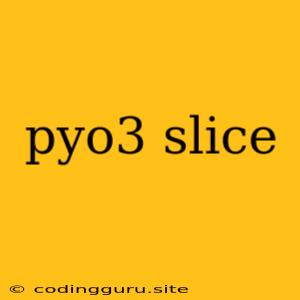Harnessing the Power of Slices in Pyo3: A Comprehensive Guide
Pyo3, the Python extension for Rust, empowers you to bridge the gap between the two languages, bringing the power of Rust's performance and safety to your Python projects. One of the most potent tools in Pyo3's arsenal is slices, allowing you to manipulate and interact with Python data structures in a seamless manner. This guide delves into the world of slices in Pyo3, exploring how you can effectively use them to enhance your Python-Rust interactions.
Understanding Slices: A Foundation for Data Manipulation
In essence, a slice in Python is a dynamic view into a sequence like a list or a string. It doesn't create a copy of the original data, but instead points to a specific portion of the sequence. This efficiency makes slices incredibly useful for manipulating and accessing subsets of data without incurring the overhead of copying.
Slices are defined using square brackets [] and specifying the start and end indices, separated by a colon :. For instance, my_list[1:3] would create a slice containing elements at index 1 and 2 from the list my_list.
Pyo3's Embrace of Slices: Empowering Python-Rust Integration
Pyo3 seamlessly integrates slices into its Python-Rust bridge, providing you with a natural and intuitive way to interact with Python data structures. Let's dive into practical examples showcasing the power of slices in Pyo3.
1. Extracting Subsets of Python Data: A Simple Example
Imagine you have a Python list my_list and you want to extract a specific portion of it using Pyo3. This is where slices shine:
use pyo3::prelude::*;
use pyo3::types::IntoPyDict;
#[pyfunction]
fn extract_subset(py: Python, my_list: &PyList) -> PyResult<&PyList> {
// Create a slice from the 2nd element to the 4th (exclusive)
let sub_list = my_list.get_slice(1, 3)?;
Ok(sub_list)
}
#[pymodule]
fn my_module(_py: Python, m: &PyModule) -> PyResult<()> {
m.add_function(wrap_pyfunction!(extract_subset, m)?)?;
Ok(())
}
In this code snippet, extract_subset takes a Python list as input and uses get_slice to extract a subset from index 1 to 3 (exclusive).
2. Modifying Data in Place: Efficiency and Flexibility
Slices in Pyo3 not only enable reading but also offer powerful capabilities for modifying Python data in place, avoiding unnecessary copies.
Let's look at an example where we modify a specific section of a Python list:
use pyo3::prelude::*;
use pyo3::types::IntoPyDict;
#[pyfunction]
fn modify_section(py: Python, my_list: &PyList) -> PyResult<()> {
// Create a slice from the 3rd element to the end
let sub_list = my_list.get_slice(2, None)?;
// Set all elements in the slice to the value "modified"
sub_list.iter().for_each(|item| {
item.set(py, "modified").unwrap();
});
Ok(())
}
#[pymodule]
fn my_module(_py: Python, m: &PyModule) -> PyResult<()> {
m.add_function(wrap_pyfunction!(modify_section, m)?)?;
Ok(())
}
In this example, modify_section extracts a slice starting from the 3rd element and iterates over it, changing each item to the string "modified" within the original Python list.
3. The Power of Iterating over Slices: Streamlined Processing
Slices provide a streamlined way to iterate over subsets of Python data. Pyo3 leverages this advantage, offering efficient iteration methods for processing data segments.
use pyo3::prelude::*;
use pyo3::types::IntoPyDict;
#[pyfunction]
fn sum_slice(py: Python, my_list: &PyList) -> PyResult {
// Create a slice from the 1st element to the 3rd (exclusive)
let sub_list = my_list.get_slice(1, 3)?;
let mut sum: u32 = 0;
// Iterate over the slice and sum its elements
for item in sub_list.iter() {
let value = item.extract::(py)?;
sum += value as u32;
}
Ok(sum)
}
#[pymodule]
fn my_module(_py: Python, m: &PyModule) -> PyResult<()> {
m.add_function(wrap_pyfunction!(sum_slice, m)?)?;
Ok(())
}
In this code, sum_slice extracts a slice and uses a for loop to iterate through its elements, summing their values efficiently.
Best Practices for Efficient Slice Usage
- Mind Your Bounds: Always be mindful of the indices you use to define your slices. Invalid indices can lead to errors.
- Mutability vs. Immutability: Be aware of the mutability of the underlying data. Modifying elements within a slice will change the original data.
- Performance: Slices are remarkably efficient, but for large datasets, consider using other methods for optimal performance.
Conclusion
Slices in Pyo3 are a powerful tool for interacting with Python data structures. They offer efficiency, flexibility, and a natural way to manipulate and process data subsets. By understanding the concepts of slices and incorporating them into your Pyo3 code, you can unlock a new level of efficiency and control in your Python-Rust projects.
